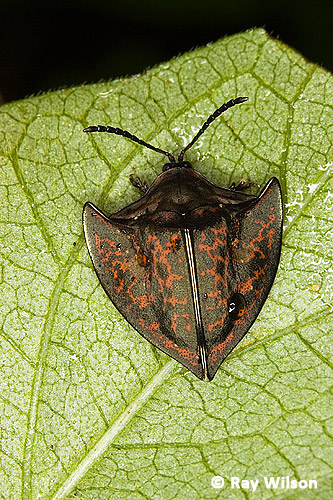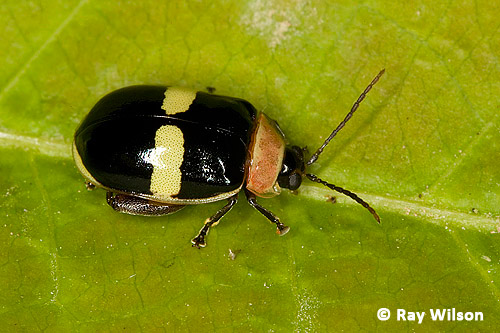
Chrysomelidae
Leaf Beetles
The Chrysomelidae are an enormous group with over 35000 species worldwide, almost all of which are plant feeders.

Cereal Leaf Beetle (Oulema melanopus) - Cheshire, England - July 2009
Some, such as Oulema melanopus are serious crop pests and can cause widespread damage to agricultural crops. This species has been the target of a successful biological control programme in the United States where it is a non-native species. Insecticides were found to be of little use in controlling the invading Oulema in the 1960's when it was causing significant damage to oat crops. By the introduction of its natural parasitoid wasp enemies the beetle infestations were finally brought under control. Of the wasp species used, one is an egg parasitoid while the other 3 attack the larvae.

Poplar Leaf Beetle (Chrysomela populi) - Anglesey, Wales - July 2008
The ladybird-like Chrysomela populi is a common species found throughout the UK on young willow and poplar trees.

Poplar Leaf Beetle (Chrysomela populi) - Anglesey, Wales - July 2008

Donacia thalassina - Lancashire, England - May 2009
Like many of its cogeners, the larvae of Donacia thalassina feed on aquatic plants and the adults can be found on the leaves and stems of plants in or near water.

Donacia thalassina - Lancashire, England - May 2009

Green Tortoise Beetle (Cassida sp.) - Anglesey, Wales - August 2008
Tortoise beetles have elytra and thoracic shields which completely cover the insect's body and legs. When sitting stationary the body is lowered onto the leaf, thus eliminating shadows and rendering the beetle practically invisible. There are about a dozen very similar species found in the UK.

Tortoise Beetle sp. - Manu, Peru - December 2008
There is a huge diversity in the shapes and colours of Tortoise Chrysomelids in tropical rainforests.

Tortoise Beetle sp. - Manu, Peru - December 2008

Tortoise Beetle sp. - Manu, Peru - December 2008
Some species of Chyrsomelidae are known to exhibit ovoviviparity. In these insects the eggs reach maturity and hatch within the reproductive tract. The female beetle then "gives birth" to the young larvae.

Manu, Peru - December 2008

Flea Beetle - Manu, Peru - December 2008
The flea beetles get their name from their ability to jump out of danger using their spring-loaded, enlarged rear femurs. Although many of the flea beetles are agricultural pests there are also a few beneficial species used as biological control agents against invasive, non-native plants.

copulating Flea Beetles (Neocrepidodera sp.) - Anglesey, Wales - July 2008

probably Clytra laeviuscula - Karlstejn, Czech Republic - July 2009
The Green Dock Beetle (Gastrophysa viridula) is a very common species in Britain, whose specific feeding preference for Dock plants (Rumex sp.) has led to proposals for its use as a bio-control agent of Dock species.

male Green Dock Beetle (Gastrophysa viridula) - Cheshire, England - June 2007
Mature female Gastrophysa viridula have abdomens so distended by the eggs she carries that her elytra no longer cover her body.

copulating Green Dock Beetles (Gastrophysa viridula) - Cheshire, England - June 2008

Anglesey, Wales - June 2008
Ray Wilson owns the copyright of all images on this site.
They may not be used or copied in any form without prior written permission.
raywilsonphotography@googlemail.com